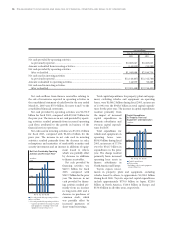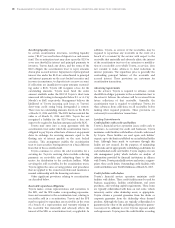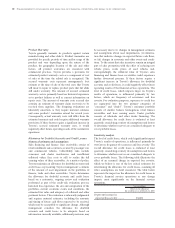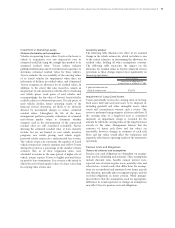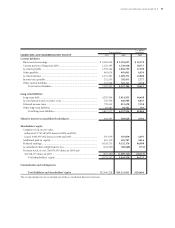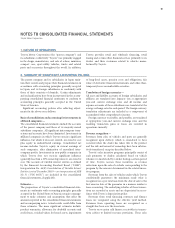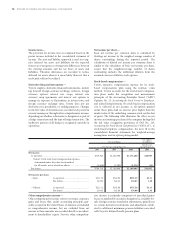Toyota 2005 Annual Report Download - page 76
Download and view the complete annual report
Please find page 76 of the 2005 Toyota annual report below. You can navigate through the pages in the report by either clicking on the pages listed below, or by using the keyword search tool below to find specific information within the annual report.
74 >MANAGEMENT’S DISCUSSION AND ANALYSIS OF FINANCIAL CONDITION AND RESULTS OF OPERATIONS
Sensitivity analysis
The following table illustrates the effect of assumed
changes in discount rates and the expected rate of return
on plan assets, which we believe are critical estimates in
determining pension costs and obligations, assuming all
other assumptions are consistent.
Yen in millions
Effect on pre-tax income Effect on PBO
for the year ending as of March 31,
March 31, 2006 2005
Discount rates
0.5% decrease .............. ¥(10,496) ¥ 128,713
0.5% increase............... 8,814 (110,883)
Expected rate of return
on plan assets
0.5% decrease .............. ¥ (4,673)
0.5% increase............... 4,673
Derivatives and Other Contracts at Fair Value
Toyota uses derivatives in the normal course of business
to manage its exposure to foreign currency exchange rates
and interest rates. The accounting is complex and con-
tinues to evolve. In addition, there are the significant
judgments and estimates involved in the estimating of fair
value in the absence of quoted market values. These
estimates are based upon valuation methodologies deemed
appropriate in the circumstances; however, the use of
different assumptions may have a material effect on the
estimated fair value amounts.
Marketable securities
Toyota’s accounting policy is to record a write-down of
such investments to realizable value when a decline in fair
value below the carrying value is other-than-temporary. In
determining if a decline in value is other-than-temporary,
Toyota considers the length of time and the extent to
which the fair value has been less than the carrying value,
the financial condition and prospects of the company and
Toyota’s ability and intent to retain its investment in the
company for a period of time sufficient to allow for any
anticipated recovery in market value.
MARKET RISK DISCLOSURE
Toyota is exposed to market risk from changes in foreign
currency exchange rates, interest rates and certain com-
modity and equity security prices. In order to manage the
risk arising from changes in foreign currency exchange
rates and interest rates, Toyota enters into a variety of
derivative financial instruments.
A description of Toyota’s accounting policies for deriva-
tive instruments is included in note 2 to the consolidated
financial statements and further disclosure is provided in
notes 20 and 21 to the consolidated financial statements.
Toyota monitors and manages these financial exposures
as an integral part of its overall risk management program,
which recognizes the unpredictability of financial markets
and seeks to reduce the potentially adverse effects on
Toyota’s operating results.
The financial instruments included in the market risk
analysis consist of all of Toyota’s cash and cash equi-
valents, marketable securities, finance receivables, securities
investments, long-term and short-term debt and all deriva-
tive financial instruments. Toyota’s portfolio of derivative
financial instruments consists of forward foreign currency
exchange contracts, foreign currency options, interest rate
swaps, interest rate currency swap agreements and interest
rate options. Anticipated transactions denominated in
foreign currencies that are covered by Toyota’s derivative
hedging are not included in the market risk analysis.
Although operating leases are not required to be included,
Toyota has included these instruments in determining
interest rate risk.


